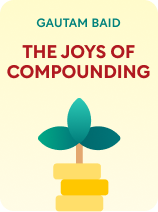

This article is an excerpt from the Shortform book guide to "The Joys Of Compounding" by Gautam Baid. Shortform has the world's best summaries and analyses of books you should be reading.
Like this article? Sign up for a free trial here.
Have you been financially unstable recently? How can you achieve financial independence?
In The Joys of Compounding, Gautam Baid gives advice for achieving financial independence. Baid underscores that financial independence is a way to boost happiness because it enables you to make value-driven choices and sidestep the anxieties linked to financial instability.
Continue reading to learn how to achieve financial independence.
Strategies That Compound Your Financial Success
Consistently using prudent financial strategies to manage your investment portfolio can compound into significant financial rewards over time. Baid’s recommendations for learning how to achieve financial independence are:
- Enhance decision-making skills.
- Assess investment value.
- Manage risk.
- Invest in social causes.
Let’s explore each of these strategies in detail.
Strategy #1: Enhance Decision-Making Skills
Sharpen your decision-making skills to excel in the world of investing. With the right approach, you can navigate the market’s intricacies, ensuring you distinguish between momentary market blips and significant changes. Baid offers the following suggestions to hone your decision-making abilities:
Think rationally: Base your decisions on logic and research rather than on emotions or biases that may cloud your judgment. This ensures you won’t be swayed by herd mentality or volatile market movements.
Follow predetermined criteria: Make checklists to guide your investment decisions. This ensures each choice undergoes rigorous evaluation and reduces the chance of oversight or impulsive actions.
Evaluate financial advice critically: Question guidance from financial consultants, understanding that their interests might sometimes diverge from yours. Always seek alternative viewpoints before making definitive decisions.
Update your knowledge: Keep informed about market shifts, global economic changes, and industry-specific trends. A well-informed stance enhances your ability to spot potential opportunities and adapt to market fluctuations.
Maintain a journal: Record each of your investment decisions, the rationale behind them, and the results they yield. This reflective practice offers clarity on past choices and provides insights for shaping future strategies.
Define and monitor your financial targets: Set clear objectives for each investment and periodically compare your portfolio’s performance to these benchmarks. This ongoing assessment helps fine-tune your approach and adapt your strategy when necessary.
Strategy #2: Assess Investment Value
Master the art of assessing investment value to strengthen your portfolio’s longevity. By delving deeper than surface-level evaluations, you can distinguish genuine investment opportunities from those that only appear promising. Here are Baid’s guidelines for understanding genuine investment value:
Pursue long-term investments: Focus on steady, sustainable growth. Choosing investments that demonstrate consistent performance over high-risk, impulsive ventures can result in substantial returns in the long run, safeguarding against short-term market fluctuations.
Look beyond stock prices: Perform a thorough company analysis, assessing its fiscal health, market position, and growth potential. This helps you identify when a company is undervalued, enabling you to seize investment opportunities that others might overlook.
Target resilient companies: Seek market leaders with distinct competitive advantages and strong profits. Such businesses have the resources to weather economic storms and consistently deliver strong returns.
Strategy #3: Manage Risk
Mitigate potential losses by mastering risk management. In a landscape teeming with unpredictability, safeguarding your investments is essential. Baid offers the following recommendations to ensure you remain shielded against unforeseen market downturns:
Anticipate various outcomes: Actively prepare for both success and failure, even in seemingly stable markets. This proactive stance protects against over-reliance on a particular asset or sector and ensures you’re not caught off-guard by market shifts.
Invest in familiar terrain: Allocate funds to sectors or industries you understand well to diminish the risk of making ill-informed choices based on market hype or misconceptions.
Minimize overhead costs: Be mindful of fees and taxes associated with your investments to ensure they don’t diminish your returns.
Diversify strategically: Distribute your investments across various sectors to shield against substantial losses from a single asset’s underperformance. However, strive for a balanced approach and avoid over-diversifying, as this approach can dilute potential returns.
Demand transparency: Prioritize businesses that favor clear communication in executive correspondence and financial reports. Such clarity often indicates trustworthy management and reduces the risk of unexpected issues or questionable tactics affecting your investments.
Buy low-priced stocks: Purchase assets when their market price is below their estimated value to create a margin of safety. This buffer guards against unforeseen market downturns and helps reduce potential losses.
Strategy #4: Invest in Social Causes
Direct your funds to social causes, reaping financial benefits while contributing to a better world. When you invest with purpose, you not only drive positive change but also ensure your portfolio mirrors your convictions. Baid’s advice for crafting value-aligned investments includes:
Prioritize purpose over profits: Treat investments as commitments to causes rather than just financial instruments. This entails evaluating the impact you want to make on society and channeling funds toward initiatives or companies that resonate with your values.
Emulate philanthropic leaders: Explore the methods of renowned philanthropists to help refine your philanthropic approach and maximize your impact on the causes you care about.

———End of Preview———
Like what you just read? Read the rest of the world's best book summary and analysis of Gautam Baid's "The Joys Of Compounding" at Shortform.
Here's what you'll find in our full The Joys Of Compounding summary:
- Why compounding isn't just a financial concept, but a transformative principle
- Strategies for compounding your well-being and happiness
- How to achieve steady and sustainable financial growth






